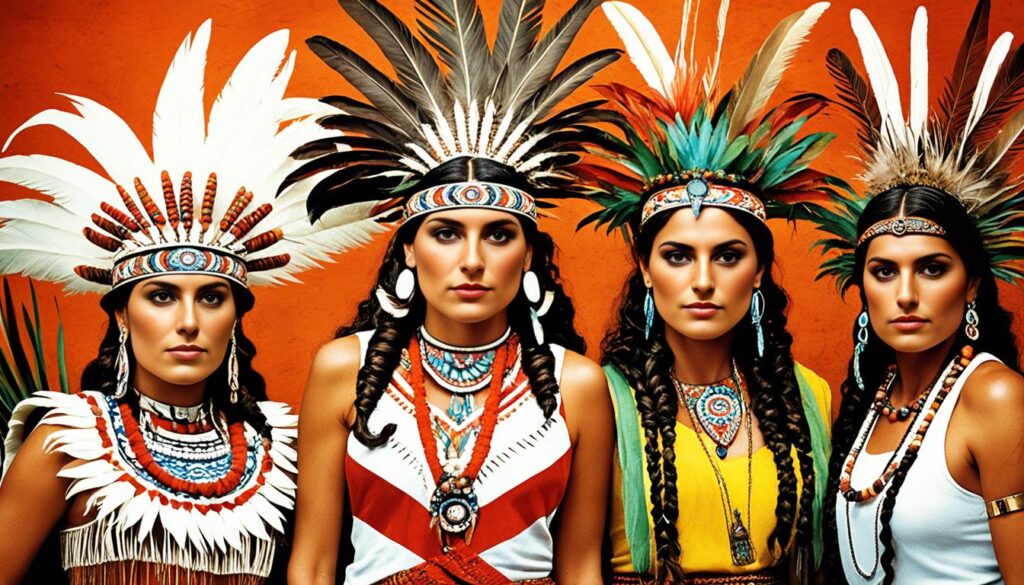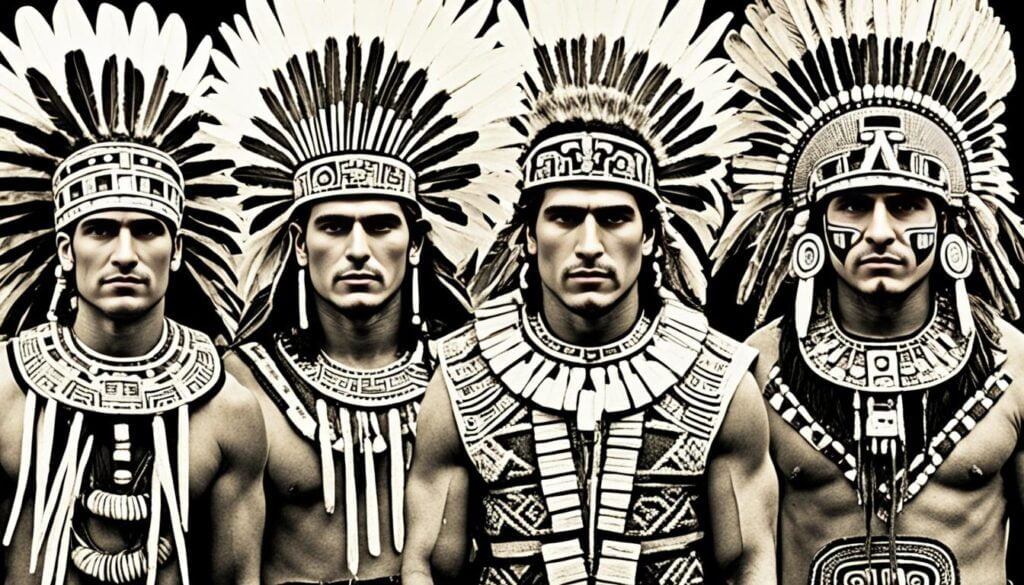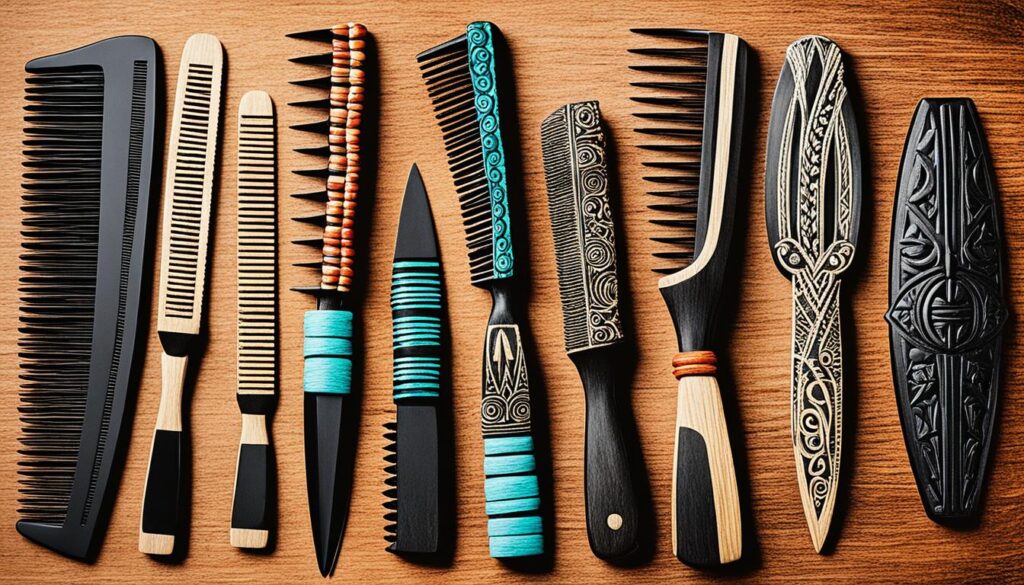
When we think of Aztec culture, images of elaborate headdresses and intricate jewelry often come to mind. But what about their hair? Did the Aztecs embrace braids as a popular hairstyle? And if they did, what meaning did it carry?
Exploring the world of Aztec hairstyles will take us on a journey through history and reveal fascinating insights into the cultural practices of this ancient civilization. From warriors to priests, noblewomen to commoners, the Aztec hairstyles were not just about fashion but also served as a means of communication and identity.
Key Takeaways:
- The Aztecs had a wide range of hairstyles that symbolized status, tribe affiliation, and occupation.
- Braided hairstyles were prevalent among married women and noblewomen.
- Men generally wore their hair at neck-length with a fringe.
- Aztec hairstyles were not just about aesthetics, but also carried deep cultural and symbolic meanings.
- Tools such as turtle shells and ribbons were used to create Aztec hairstyles.
Hairstyles Among Different Professions and Ranks
In Aztec society, hairstyles played a crucial role in distinguishing between different professions and ranks. Each group had its own unique styles that reflected their status and accomplishments. Let’s explore the fascinating variety of Aztec hairstyles across various professions.
Warrior Hairstyles
Warriors held a prominent position in Aztec society, and their hairstyles were designed to command respect and strike fear into their enemies. One distinctive warrior hairstyle was the Quachic, characterized by a stiff ridge of hair that ran from the forehead to the back of the head. This fierce and imposing style accentuated their strength and prowess on the battlefield.
Royal Hairstyles
The royalty of the Aztec Empire boasted elaborate and majestic hairstyles that showcased their noble lineage. The Tlacatecatl Lords, for example, adorned their heads with magnificent headdresses made of feathers, jewels, and intricate designs. These regal hairstyles served as symbols of power, wealth, and authority within the Aztec society.
Priest Hairstyles
Aztec priests had a unique approach to their hair. Instead of styling it, they grew their hair long and left it untended. This unkempt appearance signified the priests’ spiritual dedication and detachment from worldly matters. Long, flowing hair symbolized their connection to the gods and their role in performing religious ceremonies.
Commoner and Children Hairstyles
Commoners and children in Aztec society had simpler hairstyles compared to warriors, royalty, and priests. Commoners typically wore their hair at a medium length, sometimes tied back with ribbons or adorned with feathers. As for children, their heads were shaved until the age of ten, after which they were allowed to grow a tuft of hair at the back, symbolizing their transition into adulthood.
In summary, the Aztec society embraced diverse and distinctive hairstyles to differentiate between professions and ranks. Whether it was the fearsome warrior hairstyles, the majestic royal hairstyles, the simple commoner hairstyles, or the symbolic priest hairstyles, each style carried its own significance within the rich tapestry of Aztec culture.
Women Aztec Hairstyles
Aztec women had a diverse range of hairstyles that varied depending on their age and marital status. These hairstyles were not only a form of self-expression but also held cultural and symbolic significance within the Aztec society.
Young, unmarried women often chose to wear their hair loose, allowing it to flow freely. This natural and effortless style represented their youth and vitality. Loose hair was considered beautiful and emphasized a woman’s femininity.
On the other hand, married women typically braided or bound their hair around the head. Braided hairstyles were not only practical, keeping the hair off the face and ensuring ease of movement, but also symbolized their status as married individuals. These braids were often intricate and showcased the woman’s skill in hairstyling.
Noble women, such as princesses or high-ranking individuals, had even more ornate hairstyles. They adorned their hair with braided patterns, sometimes resembling the shape of horns, which added an air of elegance and nobility to their appearance. These elaborate styles were often accentuated with ribbons and other decorative ornaments.
Aztec Women Hairstyles
“The diversity in Aztec women hairstyles represented individuality and social standing. Whether it was the simplicity of loose hair or the intricacy of braids, women embraced their hairstyles as a powerful statement of identity.”
The hairstyles of Aztec women were not merely fashion choices; they reflected the cultural values and norms of the society. By examining these hairstyles, we gain insight into the rich tapestry of Aztec culture and the importance placed on personal appearance.
Below is a table showcasing some of the key features of Aztec women hairstyles:
| Hairstyle Type | Description |
|---|---|
| Loose Hair | Hair worn free-flowing, representing youth and femininity |
| Braided Hair | Hair bound or braided around the head, symbolizing marital status |
| Noble Women Hairstyles | Elaborate braided patterns and horn-like plaits, adorned with ribbons and ornaments, showcasing prestige and nobility |

Men Aztec Hairstyles
In Aztec society, men who were not warriors, priests, or royalty usually wore their hair at neck-length with a fringe. This commoner hairstyle was a simpler and more practical choice compared to the elaborate hairstyles of the aristocracy. Young boys had their heads shaved until the age of ten, after which they were allowed to grow a tuft of hair at the back.

While men’s hairstyles may have been less ornate, they still carried significance within the Aztec society. The neck-length hair with a fringe was a practical choice for everyday life, allowing men to maintain a neat appearance while going about their daily activities.
“The simplicity of men’s hairstyles among the Aztecs reflected their social standing, with the focus on practicality rather than elaborate adornment.”
The tuft of hair that young boys were allowed to grow at the back symbolized their transition from childhood to adolescence. It was a rite of passage that marked their growing maturity and readiness to take on greater responsibilities within the community.
Unlike the long and untamed hairstyles of the priests, the commoner hairstyles of Aztec men were easily manageable and required less maintenance. This simplicity in men’s hairstyles allowed them to focus on their daily work and duties without the distractions of elaborate grooming.
Comparing Aztec Men and Women Hairstyles
| Aztec Men Hairstyles | Aztec Women Hairstyles |
|---|---|
| Neck-length hair with a fringe | Braided hairstyles |
| Tuft of hair at the back for boys | Loose hair for young unmarried women |
| Shaved heads for young boys | Braided patterns for noble women |
| Horn-like plaits |
Hairstyles Among Different Professions and Ranks
In Aztec society, different professions and ranks were distinguished by unique hairstyles that held cultural and symbolic meanings. Let’s explore the distinctive hairstyles of warriors, priests, constables, and the master of youths.
Aztec Warrior Hairstyles
Aztec warriors were held in high regard for their bravery and valor. Their hairstyles showcased their strength and rank within the military hierarchy. Warriors adorned their heads with intricate braids, often incorporating feathers, beads, or other decorative elements. These elaborate hairstyles signified their status as protectors of the Aztec empire.
Aztec Priest Hairstyles
Aztec priests, dedicated to spiritual pursuits, grew their hair long and untended, representing their devotion to the gods. Their flowing locks symbolized their connection with the divine and their role as intermediaries between the mortal and spiritual realms. Priestly hairstyles were simple yet profound, emphasizing their sacred duty within Aztec religious practices.
Aztec Constable Hairstyles
Aztec constables were responsible for maintaining law and order within the empire. Their hairstyles were distinctive, serving as a visible representation of their authority. Constables often shaved their heads partially or completely, leaving a central strip of hair known as the tonalamatl. This unique hairstyle displayed their position of power and their commitment to enforcing Aztec laws.
Master of Youths Hairstyles
The master of youths, also known as the telpochtlatoani, oversaw the education and training of young Aztec warriors. Their hairstyle was characterized by shaved temples, leaving a prominent tuft of hair at the top. This hairstyle symbolized the transition from childhood to adulthood and marked the authority of the master of youths in shaping the future warriors of the empire.
“The hairstyles of Aztec warriors, priests, constables, and the master of youths were not just a matter of fashion but held deep cultural and symbolic significance.”
| Profession/Rank | Hairstyle Description |
|---|---|
| Aztec Warrior | Elaborate braided styles with feathers and decorative elements |
| Aztec Priest | Long and untended hair signifying spiritual devotion |
| Aztec Constable | Partially or completely shaved head with a central strip of hair (tonalamatl) |
| Master of Youths | Shaved temples with a prominent tuft of hair at the top |
Tools Used for Aztec Hairstyles
The artistry of Aztec hairstyles was enhanced by the use of various tools and accessories, allowing for intricate and elaborate designs. These tools played a crucial role in creating and maintaining the desired look. Two significant tools used for Aztec hairstyles were turtle shells and ribbons.

Turtle Shells
Turtle shells were used as a unique tool for achieving specific Aztec hairstyles. The shells were carefully shaped and sharpened to function as a razor or blade, allowing for precise hair trimming and shaping. With their sharp edges, turtle shells were effective in creating intricate patterns and designs, adding depth and complexity to the various styles favored by the Aztecs.
Ribbons
Aztec hairstyles were often adorned with vibrant ribbons, which served both aesthetic and practical purposes. Ribbons were used to tie and secure the hair, keeping it neatly in place while adding a touch of color and decoration. These ribbons were crafted using a variety of materials, including natural fibers and dyed fabrics, showcasing the Aztec people’s creativity and attention to detail.
“The use of turtle shells and ribbons allowed the Aztecs to transform their hair into intricate works of art, reflecting the rich cultural tapestry of their society.”
Together, these tools, the turtle shell, and ribbons, played a vital role in shaping and accentuating the unique Aztec hairstyles. The meticulous craftsmanship and attention to detail demonstrated in the use of these tools showcase the Aztec people’s commitment to expressing their cultural identity through their hair.
| Tools | Role |
|---|---|
| Turtle Shells | Used as a razor or blade for hair trimming and shaping |
| Ribbons | Used to tie and decorate the hair, adding color and style |
Conclusion
The Aztec hairstyles were not only a reflection of fashion trends but also deeply rooted in the cultural practices and traditions of the Aztec culture. Different professions and ranks within the society had distinct hairstyles that served as symbols of status and identity.
These hairstyles were not simply about aesthetics but carried significant cultural and symbolic meanings. From the elaborate and ornate hairstyles of warriors and noble women to the simple yet purposeful styles of commoners and children, Aztec hairstyles provided a glimpse into the diverse tapestry of hair fashion during that era.
Exploring the historical hair trends of the Aztecs offers valuable insights into their society, customs, and values. By understanding the significance and artistry behind traditional hairstyles, we gain a deeper appreciation for the richness of Aztec culture. The Aztecs embraced hairstyles as a means to express their identities and affiliations, making their hairstyles an integral part of their cultural heritage.






